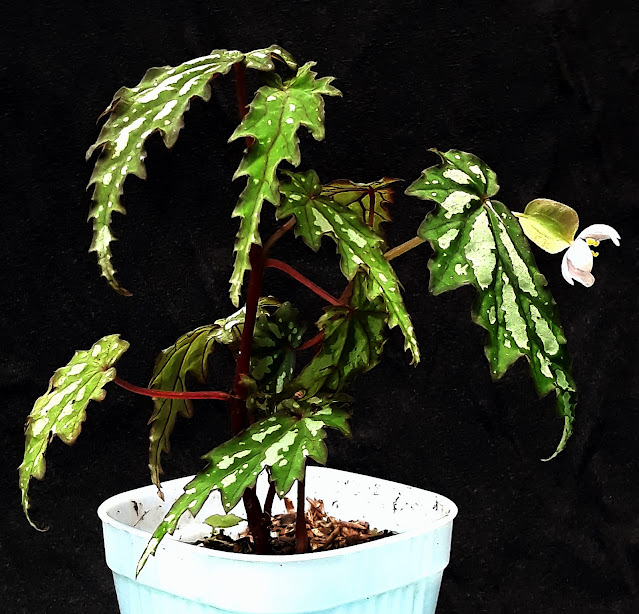'cf.', cfr., aff., sp. aff.'... huh?
You probably have seen these odd abbreviated words before, squeezed in between a plant's genus and species name. The likelihood of you encountering these is even greater if you have leanings towards botany and have seen discussions or identifications made by more seasoned botanists. And since this is a very seldom discussed topic, I do sometimes get queries what these abbreviations are for. This time I'll let the information go public and save time and effort mansplaining botanical mumbo-jumbo through private messages.
cf. and cfr.
Both of these are just abbreviations of the same word, confer. However, confer here refers to a Latin word and not the one in English usage. A direct translation into English of the Latin confer is 'compare' and this is often wedged in between a genus and a species name to convey how the plant in question is comparable in appearance to an already known species. This is often employed in social media discussions when pictures of a plant are posted but the original poster failed to take pictures of the important parts, making exact identification uncertain. Thus, when we say 'Clerodendrum cfr. wallichii', it does not automatically mean that the plant is Clerodendrum wallichii. Maybe it is, but the available information- the pictures and relevant information such as the plant's locality- are not workable enough to permit the plant's exact identification. Unfortunately, plants identified online with a 'cf' or a 'cfr' gets tossed around with these disclaimers omitted even when there is no closure yet regarding the plant's exact identity. Maybe it's laziness, but sometimes also as a credit-grabbing attempt to make it appear that the person who asked for the plant's identification in the first place, knows what it is in his subsequent posts about it. I know because I have observed neophytes do this, often.
aff. and sp. aff.
'aff.' is abbreviation for the Latin 'affinis', the source of the English word 'affinity'. 'sp. aff.' is 'species affinis' and not 'species affinity' as at least one vlogger- who I admire- is apt to say in his videos. 'aff.' denotes a relationship, not just a comparison like in the case of 'cfr.' Both 'aff.' and 'sp. aff.' can be used interchangeably. However, many people appear to use 'cfr.' and aff.' as interchangeable terms too. This is only an opinion, but I think the two have differences. These differences might be subtle to some, so read carefully.
'cfr.' only means that one has compared the subject at hand to a known taxon. It is often used when the person who identified it does not have the plant at hand, and with very limited information given by the person asking for the name, can only make an educated guess. 'aff.' is much more sure and is resorted to when the botanist either has the plant at his disposal or the person asking for its identification did send a very good set of photos and relevant information AND the plant still evades certain identification. An 'aff.' or 'sp. aff.' often refers to potentially undescribed taxa and with proper description and naming still pending, will temporarily use the name of the plant closest to it.
 |
| Pinanga aff. philippinensis. Acording to botanist Jiro Adorador, it is nearest to P. philippinensis and may prove to be an infrataxon. |
When not to use 'aff.' and 'cfr.'
In many instances, it is just not possible to make a guess even the plants' nearest look-alikes or relatives. Plants that fall in this category are usually those with very distinctive features that are absent in other species. Think of how Nepenthes rajah was and still remains a singular taxon that is unlikely to be confused with any other species. It may have its relatives, but it does not look like any of its relatives. Another scenario is if the plant is difficult to pin down to species level because it was found to be sterile (without flowers). In such instances, only use 'sp.' (e.g. Aristolochia sp. or Ceropegia sp.) until its identity has been resolved.
In a nutshell, when someone identifies a plant for you and he places a 'cf.' or a 'cfr.' in between the scientific names, he is essentially asking you to compare your plant to the species name he just gave you because that is what 'cfr.' literally translates to- compare. The person who supplied you the name has given you the lead. It is up to you to compare the plant that you have/saw to the name given to you and confirm or refute if it is indeed that plant or not. It neither implies relationship nor sameness; it can only be established much later when someone with a better set of photos or more trained eyes can have a look at the actual plant. An 'aff.' or a 'sp. aff.' conveys relationship. It is comparable to the species name given, but since it (probably) has no formal name yet, then it has to temporarily borrow a name from its supposed nearest affinity just so we have a name to refer to it in the meantime.



Comments
Post a Comment